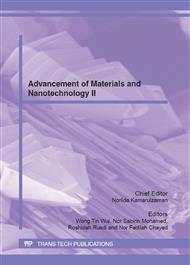p.204
p.209
p.214
p.223
p.229
p.235
p.240
p.247
p.251
Effects of Ramp Rates with Short Holding Time on the Sinterability of Hydroxyapatite
Abstract:
Hydroxyapatite (HA) is by far the closest match to the human bone in terms of chemical composition. Furthermore, HA boasts excellent biocompatibility thus earning its reputation for human bone replacement. However, HA lacks desirable mechanical properties (i.e. hardness, fracture toughness, etc.). Due to the poor heat conductivity of ceramics, it is hypothesized that HA when sintered via conventional pressureless sintering, smaller ramp rates are advantageous as oppose to larger ramp rates. These advantages can be observed as improved densification along with improved mechanical properties. In the present work, the sintering profile for the HA green bodies were held at 1 minute in comparison to the usual 2 hours holding time. The applied ramp rates were 2 °C/min, 5 °C/min and 10 °C/min. Sintering temperatures were set to 1000, 1100, 1200, and 1300 °C. Sample characterization was then reviewed in the aspects of phase stability, % shrinkage, bulk and relative density, Young’s modulus, Vickers hardness, as well as fracture toughness. The results revealed that sintering with shorter holding time yielded an improvement in the mechanical properties of HA. It was observed that sintering HA with a 2 °C/min ramp rate does not result in the formation of extrageneous phases even when sintered to 1300 °C. Similarly at 2 °C/min and 1300 °C, densification was observed to be 99.05 %. In addition, Young’s modulus recorded its highest value (117.03 GPa) when sintered with a ramp rate of 2°C/min. It was also observed that sintering HA at a ramp rate of 2°C/min produced a hardness value of 5.88 GPa (improvement of 0.68 GPa when compared with 2 hours holding time).
Info:
Periodical:
Pages:
229-234
Citation:
Online since:
July 2012
Keywords:
Price:
Сopyright:
© 2012 Trans Tech Publications Ltd. All Rights Reserved
Share:
Citation:


